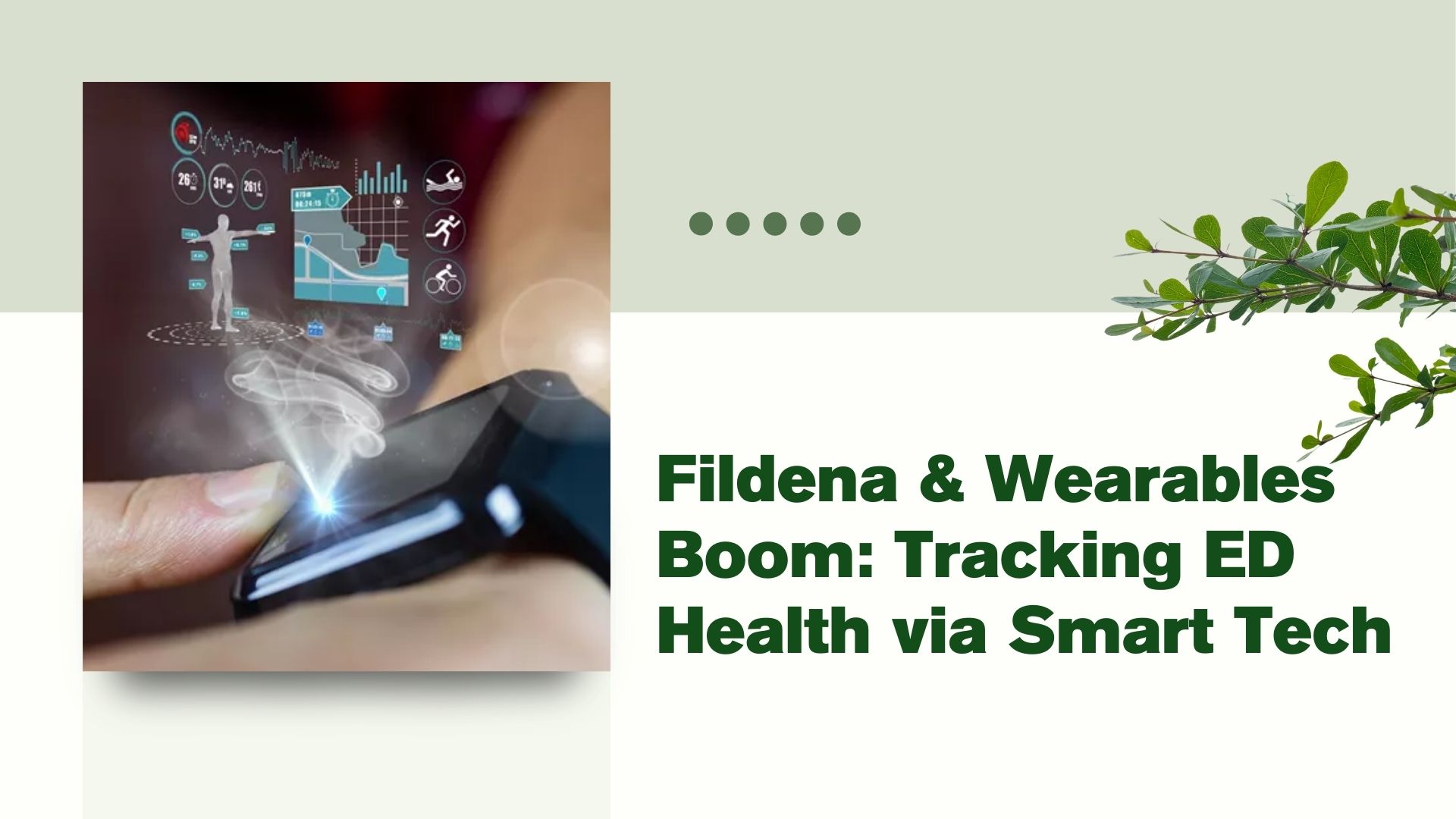The year 2025 has ushered in a new era of wearable tech that is transforming personal health management. From fitness trackers to advanced medical sensors, the ability to monitor one’s body in real time has become a defining feature of modern healthcare. For men managing erectile dysfunction (ED), the integration of Fildena wearables with smart health platforms is a breakthrough. Patients can now track ED health metrics, anticipate risks, and optimize Fildena treatment through real-time data. This convergence of smartwatch ED monitoring and telehealth services has the potential to reshape the sexual health landscape in the United States and beyond.
📊 Smartwatch Data Predicting Early ED Symptom Detection
Smartwatches today are equipped with sensors that measure heart rate variability, blood oxygen levels, stress indicators, and sleep cycles. These parameters are directly connected to erectile health. By analyzing trends, wearable devices can flag potential ED risk factors such as hypertension, high cholesterol, obesity, or chronic stress.
For instance:
- A consistent decline in nocturnal erections measured via wearable tech sensors could be an early indicator of vascular ED.
- Elevated resting heart rates may point to cardiovascular strain, often correlated with erectile problems.
- Poor sleep quality, detected via smart health tracking, can highlight hormonal imbalances that influence testosterone levels.
By collecting such data, smartwatch ED monitoring integrated with Fildena ensures that patients recognize warning signs before severe symptoms emerge, enabling earlier lifestyle adjustments and timely therapeutic intervention.
🖥️ Wearables Integrating with Telehealth Fildena Services
The wearables and ED telehealth platforms has become a hallmark of smart health innovation. Patients no longer need to rely solely on in-clinic visits. Instead, they can connect their wearable data to telehealth providers who prescribe Fildena.
Here’s how it works:
- Data Sync: Wearable tech continuously uploads metrics such as blood flow levels, heart performance, and stress markers to secure telehealth platforms.
- Clinical Review: Physicians evaluate patterns and recommend adjustments to Fildena dosage or timing.
- Remote Prescriptions: Medications like Fildena can be ordered online—exclusively via Medicoease—ensuring privacy and convenience.
- Progress Tracking: Regular teleconsultations analyze whether Fildena optimization is improving outcomes, supported by real-time data for Fildena optimization.
This digital loop empowers patients to stay in touch with their doctors while actively tracking their progress at home.
💊 Cenforce 100: A Related Player in the Smart Tech Era
While Fildena is at the forefront of this transformation, other ED medications like Cenforce 100 are also entering the wearable health conversation. Cenforce 100, a sildenafil citrate-based medication, works similarly to Fildena in improving erectile function by enhancing blood flow to the penis. Patients using Cenforce 100 can equally benefit from wearable integrations.
For instance, a patient taking Cenforce 100 can use wearable data to track cardiovascular responses during sexual activity. By monitoring blood pressure and heart rate fluctuations, they can ensure safe use of the medication while also sharing this information with healthcare providers. As a result, Cenforce 100—like Fildena—becomes part of a larger, data-driven health strategy that prioritizes safety, personalization, and long-term well-being.
📈 Real-Time Tracking of Sexual Health Metrics via Tech
In 2025, wearable technology has expanded beyond basic steps and calories. For ED management, the focus has shifted to real-time data collection that relates directly to sexual performance.
Modern Fildena wearables can:
- Track penile rigidity during nocturnal sleep cycles.
- Monitor hormonal fluctuations linked to libido.
- Assess blood circulation patterns that influence erectile quality.
- Log stress spikes before sexual activity, correlating anxiety with performance outcomes.
Such real-time tracking of sexual health metrics via tech enables a more scientific evaluation of Fildena’s effectiveness. Instead of subjective feedback, patients and clinicians rely on quantified data, reducing guesswork and making therapy more efficient.
🔐 Privacy Risks of Storing ED-Related Wearable Data
While the benefits of wearable tech in ED tracking are remarkable, data privacy remains a pressing issue. Erectile health is among the most sensitive categories of medical information.
Risks include:
- Unauthorized Access: Hackers targeting cloud platforms that store intimate health metrics.
- Insurance Bias: Concerns that insurers may misuse data to adjust premiums based on sexual health performance.
- Employer Misuse: Potential risk of workplace discrimination if ED health data is leaked.
To mitigate these concerns, companies producing Fildena wearables must adhere to strict encryption standards, anonymize patient identities, and provide clear consent frameworks. In 2025, federal discussions in the U.S. about digital health data protection laws are central to ensuring safe adoption of ED monitoring technologies.
🤝 Partnerships Between Fildena Makers and Tech Firms
The growth of smart health is driving collaborations between pharmaceutical companies and technology giants. Manufacturers of Fildena are exploring alliances with smartwatch developers, AI health startups, and data analytics firms.
Key developments include:
- AI Integration: Algorithms predicting Fildena response times based on wearable-captured physiology.
- IoT Devices: Smart rings and patches that transmit real-time sexual health metrics directly to Medicoease dashboards.
- Consumer Apps: Personalized ED trackers that sync Fildena intake with lifestyle factors such as diet, exercise, and sleep.
Such partnerships allow patients to benefit from wearable tech tracking ED health metrics while ensuring optimized dosing and enhanced therapy outcomes.
💲 Insurance Incentives for Using Wearable ED Monitoring
Health insurers in the U.S. are beginning to recognize the financial logic of incentivizing wearable usage for chronic conditions—including ED. Since erectile dysfunction is closely tied to cardiovascular disease, diabetes, and obesity, encouraging ED tracking through wearables lowers long-term costs.
Possible incentives include:
- Premium Discounts: For policyholders regularly uploading ED health metrics through approved platforms.
- Medication Subsidies: Coverage improvements for patients proving adherence to Fildena treatment using wearables.
- Wellness Credits: Reward points for lifestyle improvements measured through smart health devices.
With insurance incentives for wearable ED use, the barrier to adopting Fildena wearables becomes lower, making advanced ED management accessible to a broader population.
🔮 Future Wearable Trends Supporting ED Treatment Adherence
The next wave of Fildena wearables will likely go beyond current smartwatch and ring-based designs. Anticipated innovations include:
- Biochip Sensors: Implanted microchips delivering continuous erectile health metrics to patient smartphones.
- Smart Textiles: Clothing embedded with sensors to monitor circulation and stress while patients go about daily life.
- Neuro-Wearables: Brainwave monitors detecting psychological triggers of ED, such as anxiety or depression.
- Adaptive Dosing Alerts: Apps that notify users when to take Fildena based on real-time data for Fildena optimization.
Together, these future wearable trends promise to make adherence to Fildena therapy more intuitive, effective, and personalized.
❓ FAQ
Q1: How does wearable tech help ED patients using Fildena?
Wearable tech allows patients to monitor heart rate, circulation, sleep, and stress, all of which affect erectile health. This data supports Fildena optimization in real time.
Q2: Can smartwatches detect early ED symptoms?
Yes. By analyzing patterns such as nocturnal erections, heart performance, and stress markers, smartwatch ED monitoring integrated with Fildena can reveal early warning signs.
Q3: Where can patients buy Fildena online?
Fildena can be purchased safely and discreetly only through Medicoease, ensuring reliable access.
Q4: What are the privacy concerns with wearable ED tracking?
Data leaks, misuse by insurers, and workplace discrimination are major risks. Strong encryption and patient consent are essential safeguards.
Q5: Do insurers offer benefits for ED wearables?
Yes. Some insurers provide premium discounts, subsidies, or wellness credits when patients use wearables and ED telehealth platforms to track their health.
Q6: How accurate are Fildena wearables?
Modern sensors offer highly reliable metrics, though they work best when paired with physician consultations and real-time data reviews.
Q7: Can Fildena wearables connect to telehealth?
Absolutely. Wearables seamlessly sync with telehealth platforms, allowing doctors to remotely monitor progress and adjust therapy.
Q8: Will future wearables replace doctor visits?
No. They enhance, but do not replace, medical consultations. Instead, they act as continuous support tools for Fildena therapy adherence.
Q9: Are ED wearables only for older men?
Not at all. ED can affect men across different age groups, and wearable tech provides preventive benefits even for younger users.
Q10: What future trends are expected in ED tracking?
Smart textiles, biochips, and adaptive AI dosing alerts will likely dominate the smart health landscape for ED management.



